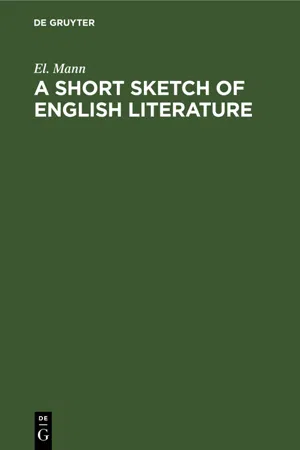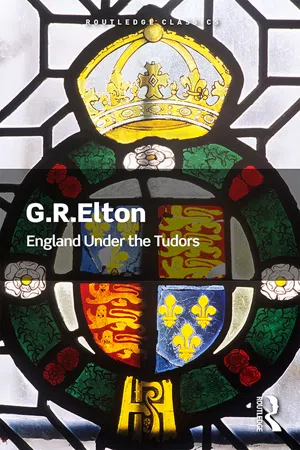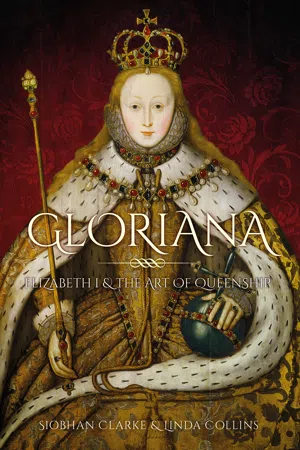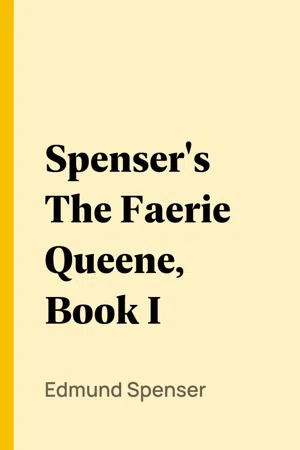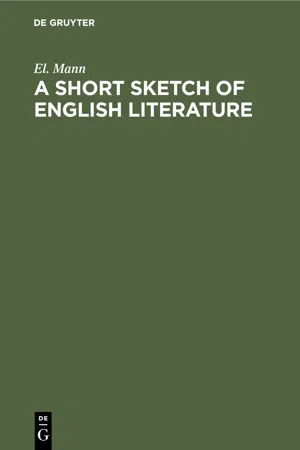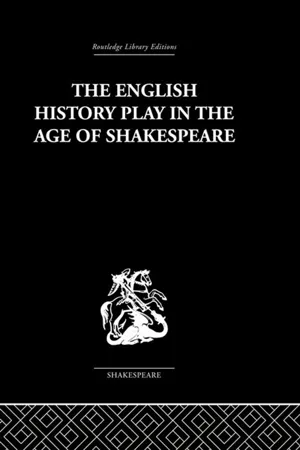Literature
Elizabethan Age
The Elizabethan Age refers to the period of English history during the reign of Queen Elizabeth I, from 1558 to 1603. It was a time of great cultural and literary achievement, with the works of William Shakespeare, Christopher Marlowe, and Edmund Spenser flourishing. The literature of this era is characterized by its exploration of human nature, political intrigue, and the complexities of love and power.
Written by Perlego with AI-assistance
Related key terms
1 of 5
8 Key excerpts on "Elizabethan Age"
- eBook - PDF
A Short Sketch of English Literature
From Chaucer to the Present Time
- El. Mann(Author)
- 2020(Publication Date)
- De Gruyter(Publisher)
The Elizabethan Period. 9 T h e E l i z a b e t h a n P e r i o d . 1558—1642 (including the reign of James I., and that of Charles I., to the out-break of the Civil War.) This period which includes the reign of James I. and partly that of Charles I., extends over a much greater space than the reign of Queen Elizabeth proper. As it was the most brilliant in English literature, its influence continued to be felt for a long time. The drama constituted its chief literary feature; and its close is contemporary with the outbreak of the Civil War.' It contains the noblest names of English literature, those of Spenser, Shakspeare, Hooker, Bacon, besides a host of others who have almost been overlooked in the crowd. The reign of Elizabeth was also one of important political activity and the time of great discoveries, and counted as many heroes as poets, and not seldom, both these characters were united in the same per-son, as in the case of Sir Philip Sidney (1554—1586). A far greater poet, Edmund Spenser (1553—1599), the author of the Fcerie Queene (Fairy Queen), was a native of London. He was descended from a good family, though not rich, and received his education at the university of Cambridge. When he left the university, he resided for some time in the north of England, and there published his first poem, The Shepherd's Calendar, a series of pastorals, divided into twelve parts or months. A friend, (Mr. Gabriel Harvey), persuaded him to return to London and introduced him to Sir Philip Sidney, himself a poet and one of the greatest ornaments of the brilliant court of Elizabeth. Sidney, in his turn, recommended the poet to Dudley, Earl of Leicester (his uncle) the favourite of Eliza-beth, and after a long delay, he received a grant of for-feited land in the county of Cork, Ireland. - eBook - ePub
- G.R. Elton(Author)
- 2018(Publication Date)
- Routledge(Publisher)
Cantiones Sacrae , Wilbye at his best, or Dowland’s sad, sweet songs. In the reign of Elizabeth, England reached the highest concentration of musical genius in all her history and led Europe in this field.3. LiteratureAny attempt to summarise here the work of the writers, poets, and dramatists who made of the sixteenth century one of the few really great periods of literature must obviously be hopeless. It was in language and its use that the English Renaissance mainly expressed itself. The visual arts played little part in it; music recorded astonishing achievements but for technical reasons remained a restricted expression of the age; in poetry, on the other hand, no more remarkable work has ever been done. Within the short space of some sixty years, and thanks to the labours of a few men of genius and many men of unusual talent, the English language shed the awkwardness and insufficiency which clung to it and became the flexible and all-competent instrument of an incomparable out-pouring. The greatest of all poets (perhaps in any language) was part of that band, but others beside Shakespeare added their efforts—more than can be listed here. Another difficulty is raised by the fact that the death of Queen Elizabeth marked a date of no importance in this story. There are differences between the Elizabethans and Jacobeans, but the significant years are really 1580–1630. Yet we cannot include here the whole reign of James I. As far as possible we shall therefore confine ourselves to work done before Elizabeth died and to men who were prominent before 1603, taking three subjects in turn—prose, lyrical poetry, and the drama.Prose has always been later to reach perfection than poetry because poetic language is always the first to undergo the discipline of literary treatment. The age of Elizabeth is no exception. Some decent literary prose appeared under Henry VIII, though most of it was cumbersome and long-winded; under the influence of their Greek and Latin studies, Cheke and Ascham wrote a clear if rather pedestrian style; but when the literary men really got hold of prose they did terrible things to it. Dissatisfied with the plainness of daily speech and the artlessness of his predecessors, John Lyly, in his two romances Euphues (1579) and Euphues his England (1580), developed a style of his own which, by the name of Euphuism, became the model and bane of English writing. Its essence lay in a laborious display of rhetorical devices; Lyly was particularly fond of pointless but well-balanced antitheses, frequent alliteration, a prodigality of similes arranged in wearisome strings, and rhetorical questions. Sir Philip Sidney’s Arcadia (c. 1580) suffers from much the same faults, though they are less glaring; oddly enough—in view of the large number of versified romances that ought to have been in prose—the episodic and often exalted Arcadia - eBook - ePub
Gloriana
Elizabeth I and the Art of Queenship
- Linda Collins, Siobhan Clarke(Authors)
- 2022(Publication Date)
- The History Press(Publisher)
7
ELIZABETHAN ARTS: THE GOLDEN AGE
‘AND SHE THE QUEENE OF MUSES IS ’MICHAEL DRAYTONThe Golden Age of Elizabethan arts reached its height in the last decade or so of the Queen’s reign, from the 1590s until her death in 1603, when the English Renaissance fully blossomed. Drama was the dominant art form, attracting an estimated 15,000 people from the growing population of London to attend the theatre each week. Christopher Marlowe was arguably the first great playwright of the era, but after his death in 1593, it was William Shakespeare who dominated the London theatre.The Royal Shakespeare Company consider The Taming of the Shrew to be the dramatist’s earliest play, believed to have been written before 1592. Two Gentlemen of Verona , A Midsummer Night’s Dream and Richard II are examples from the mid-1590s. Hamlet was written around 1600 and All’s Well that Ends Well is thought to span the period between the death of Elizabeth and the coronation of James I. Macbeth (also known as ‘The Scottish Play’) and King Lear are among a large body of work that falls within the Jacobean period.GLORIANA AND THE ELIZABETHAN STAGE
In the early days of Elizabeth’s rule, the morality plays of the medieval era were still being performed, as were stories enacted by strolling players. These were tales written in the vernacular, acted by semi-professional groups, generally in the streets, without scenery and with a minimum of props. But as Elizabeth’s reign progressed, plays became more complex, playhouses opened and the stage of the later Tudor era became accessible to the public on a level that was only rivalled by the Church. Theatregoing became hugely popular with the poorer classes, who somehow found the time and money to go and see plays that today might be considered elitist.The first purpose-built playhouse was the unimaginatively named Theatre, opened in Shoreditch in 1576, followed by the Curtain a year later. By 1587 the Rose, known for its connections with Christopher Marlowe, had been built beside the Thames in Southwark. In 1572, players were defined as vagabonds and criminals who were subject to arrest, whipping or branding. Religious and civic authorities condemned the playhouses as a scandal and an outrage. To avoid prosecution, theatres clustered around the Southwark area, which was known as a ‘liberty’. In other words, it was outside the city boundaries, beyond the control of the Lord Mayor, and a part of London where all sorts of prohibited activities could take place openly. The original Globe Theatre opened in Southwark in 1599, to house a group of players known as the Lord Chamberlain’s Men. They were a company of six actors who each took shares in the theatre to fund its construction. The young William Shakespeare was a member and wrote most of their plays. His genius for wordplay and dramatic dialogue was unprecedented. - eBook - ePub
- Edmund Spenser, George Armstrong Wauchope, (Authors)
- 2005(Publication Date)
- Perlego(Publisher)
Add to this intense delight in life, with all its mystery, beauty, and power, the keen zest for learning which filled the air that men breathed, and it is easy to understand that the time was ripe for a new and brilliant epoch in literature. First among the poetic geniuses of the Elizabethan period came Edmund Spenser with his Faerie Queene, the allegory of an ideal chivalry. This poem is one of the fruits of that intellectual awakening which first fertilized Italian thought in the twelfth century, and, slowly spreading over Europe, made its way into England in the fifteenth century. The mighty impulse of this New Learning culminated during the reign of the Virgin Queen in a profound quickening of the national consciousness, and in arousing an intense curiosity to know and to imitate the rich treasures of the classics and romance. Its first phase was the classical revival. The tyrannous authority of ecclesiasticism had long since been broken; a general reaction from Christian asceticism had set in; and by the side of the ceremonies of the church had been introduced a semi-pagan religion of art—the worship of moral and sensuous beauty. Illiteracy was no longer the style at court. Elizabeth herself set the example in the study of Greek. Books and manuscripts were eagerly sought after, Scholars became conversant with Homer, Plato, Aristotle, and the great tragic poets Sophocles, Euripides, and Æschylus; and translations for the many of Vergil, Ovid, Plautus, Terence, and Seneca poured forth from the printing-presses of London. The English mind was strongly tempered by the idealistic philosophy of Plato and Aristotle, and the influence of Latin tragedy and comedy was strongly felt by the early English drama. Along with this classical culture came a higher appreciation of the beauty of mediævalism - No longer available |Learn more
- William Edward Simonds(Author)
- 2012(Publication Date)
- Barnes & Noble(Publisher)
CHAPTER III THE FIFTEENTH AND SIXTEENTH CENTURIESFROM CHAUCER TO SHAKESPEAREI. The Fifteenth Century: The Renascence. II. The First Half of the Sixteenth Century: From the Accession of Henry VIII. (1509) to the Accession of Elizabeth (1558). III. Representative Prose and Verse in the Elizabethan Age. IV. The Development of the English Drama. V. William Shakespeare and his Successors.I. THE FIFTEENTH CENTURY: THE RENASCENCE .THE century immediately following that of Chaucer and his contemporaries is apparently one of the most unproductive in the history of English literature. It is to be recognized, however, as a time of preparation, and not without its important achievements.The fifteenth century was the century of the "new birth," or renascence, of learning and art in the life of the modern world. It was a period of invention and discovery, producing results which were momentous in subsequent history. New ideas poured in upon men's minds and greatly changed the manner of thinking in philosophy, art, literature, politics, and religion. The whole of Europe was under the spell of this new-born spirit of light and progress, but the centre of greatest influence and the chief source of power was Italy, the home of Dante and Petrarch; of da Vinci, Raphael, and Michelangelo; of the Medici family, magnificent patrons of learning and art, and of hundreds of scholars whose names are less familiar, but who created a taste for the literature and thought of the classic age and taught that literature in the schools of Padua, Bologna, Venice, and Florence. This Revival of Letters was stimulated by the fall of Constantinople in 1453, which sent swarms of Greek scholars westward into Europe, bearing precious manuscripts of Greek philosophers and poets to quicken enthusiasm for the study of this new-old literature. In Germany the new spirit of freedom in thought produced the Reformation, and the scholarship of Melanchthon, Reuchlin, and Erasmus. In England these new ideas, heralded in the preceding century by Wyclif and Chaucer, were fostered and taught by Grocyn, Erasmus, Colet, Ascham, and More. New colleges were established at Cambridge and Oxford, and public schools were founded here and there in the kingdom. As feudalism decayed, the rights of the untitled class were recognized and a new independence was given to the commoner. - eBook - PDF
A Short Sketch of English Literature
From Chaucer to the Present Time
- El. Mann(Author)
- 2020(Publication Date)
- De Gruyter(Publisher)
- 1 0 - in the imaginary island of Utopia. The book was written in Latin. The Bible was for the first time translated from the original Hebrew and Greek, the New Testament in 1525 by William Tyndale (burnt in Flanders in 1536) and the whole Bible in 1535 by Miles Coverdale. These ver- sions have fixed the English language once for all. T h e E l i z a b e t h a n P e r i o d from 1558 —1(342 (including the reign of James I, and that of Charles I, to the out- break of the Civil War.) This period which includes the reigns of James I and partly that of Charles I, extends over a much greater space than the reign of Queen Elizabeth proper. As it was the most brilliant in English literature, its influence continued to be felt for a long time. ' The drama constituted its chief literary feature; and its close is contemporary with the outbreak of the Civil War. It contains the noblest names of English literature, those of Spenser, Shakspeare, Hooker, Bacon, besides a host of others who have almost been overlooked in the crowd. The reign of Elizabeth was also one of important political activity and the time of the great discoveries, and counted as many heroes as poets, and not seldom, both these characters were united in the same per- son, as in the case of Sir Philip Sidney (1554—1586). A far greater poet, Edmund Spenser (1553—1599), the author of the Faerie Queene (Fairy Queen), was a native of London. He was descended from a good family, though not rich, and received his education at the university of Cambridge. When he left the university, he resided for some time in the north of England, and there published his first poem, "the Shepherd's Calendar", a series of pastorals, divided into twelve parts or months. A friend, (Mr. Gabriel Harvey), persuaded him to return to London and introduced him to Sir Philip Sidney, himself a poet - 1 1 - and one of the greatest ornaments of the brilliant court of Elizabeth. - Irving Ribner.(Author)
- 2013(Publication Date)
- Routledge(Publisher)
CHAPTER ONE History and Drama in the Age of Shakespeare T he type of history play which flourished in the age of Shakespeare was particularly an expression of the English Renaissance. Although its roots are deep in the medieval drama, it reached its full development in the last years of the reign of Elizabeth, and when John Ford wrote his Perkin Warbeck, it was with the awareness that he was reviving a dramatic type which had been dead for some decades. It is significant that later attempts to revive the history play often have been with an eye towards the Elizabethan era. Nicholas Rowe turned to his Jane Shore fresh from his edition of Shakespeare and full of the inspiration of Shakespeare’s histories. In our own time Maxwell Anderson, in such plays as Elizabeth the Queen and Anne of the Thousand Days, has attempted to re-create Elizabethan verse drama, and it is significant that he has chosen his subjects from the very age he has sought to emulate. To define the Renaissance history play as a distinct dramatic genre, however, has not been easy, although many attempts have been made. It is now, more than ever, necessary to so define it, for in the half century that has gone by since the appearance of Professor Felix E. Schelling’s pioneer study, 1 our knowledge both of Elizabethan drama and of Renaissance historiography has increased vastly, and the time has come for a re-examination of the entire field of Elizabethan historical drama. But before we can begin to write of the English history play, we must decide by what specific standards we may distinguish history plays from other plays of the Elizabethan era. The special use of the term ‘histories’ in the Shakespeare folio of 1623 is, as we shall see, of little help in this respect- No longer available |Learn more
The Broadview Anthology of British Literature: Concise Volume A - Third Edition
The Medieval Period - The Renaissance and the Early Seventeenth Century - The Restoration and the Eighteenth Century
- Joseph Black, Leonard Conolly, Kate Flint, Isobel Grundy, Wendy Lee, Don LePan, Roy Liuzza, Jerome J. McGann, Anne Lake Prescott, Barry V. Qualls, Jason Rudy, Claire Waters(Authors)
- 2016(Publication Date)
- Broadview Press(Publisher)
The Drama The flowering of drama in England from the late 1580s to the 1620s is widely accepted as the greatest cultural achievement in the history of English literature. The list of important dramatists who flourished during this period includes not only Marlowe, Shakespeare, and Jonson but also Thomas Kyd, John Lyly, George Peele, John Webster, Cyril Tourneur, Francis Beaumont, John Fletcher, Thomas Middleton, John Ford, James Shirley, John Marston, Thomas Dekker, Thomas Heywood, and Philip Massinger. It is an outpouring the more remarkable for there being so few advance signs of its coming. In the middle years of the sixteenth century, the main forms of medieval drama were very much alive: audiences were still watching guild-sponsored biblical plays, allegorical dramas such as Everyman, and various kinds of (generally crude) secular comedy 588 Broadview Anthology of British Literature performed by traveling troupes of players or local inhabitants as part of feast-day celebrations. As the forces behind the Protestant Reformation gathered steam, however, a substantial body of opinion became convinced that neither the popular secular drama nor the often irreverent representations of religious material in the biblical plays were proper to be played at all: a key factor in the demise of the biblical plays is thought to have been hostility from those sympathetic to the Protestant Reformation. As the biblical plays were dying out, the revival of classical literature ushered in by humanism helped give birth to new forms of English drama. The first phase in the introduction of these new models was the translation of classical plays, particularly Roman tragedies by Seneca and Roman comedies by Plautus and Terence. Of the two, it was Roman comedy that first had an impact in England, with English schools and colleges presenting comedies by Plautus or Terence to school audiences (or occasionally to aristocratic ones, by invitation).
Index pages curate the most relevant extracts from our library of academic textbooks. They’ve been created using an in-house natural language model (NLM), each adding context and meaning to key research topics.
